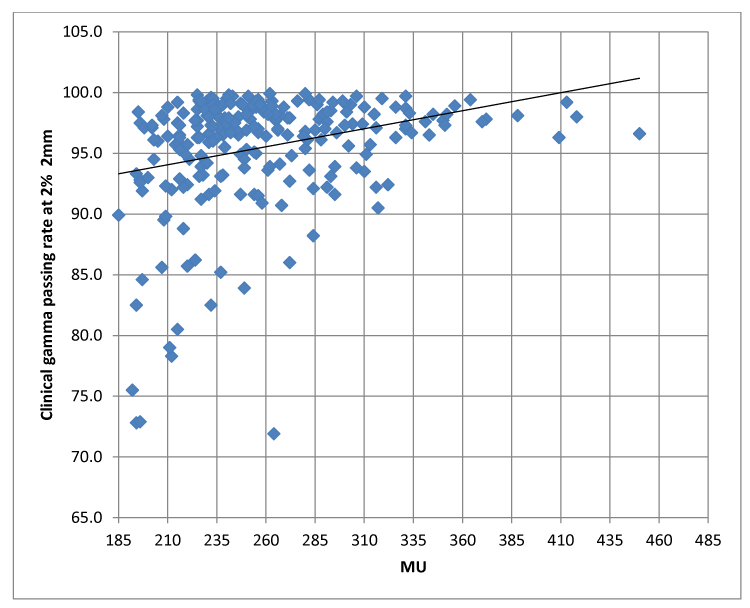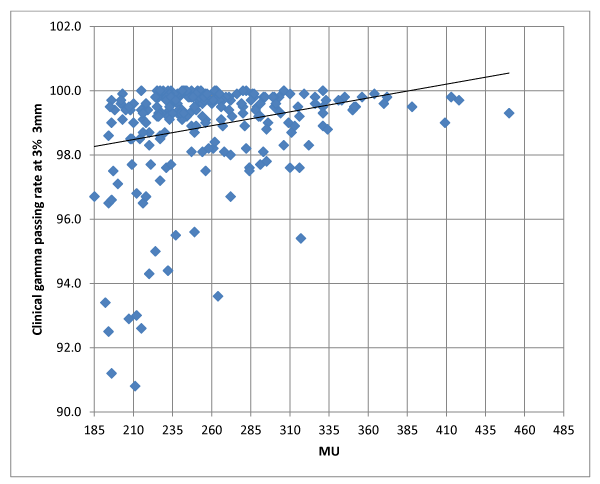International Journal of Radiology and Radiation Oncology
Negative correlation of patient-specific quality assurance failure rates with Monitor Units for Volumetric-Modulated Arc Therapy
Murshed Hossain and Nathan M Papalia*
Cite this as
Hossain M, Papalia NM (2020) Negative correlation of patient-specific quality assurance failure rates with Monitor Units for Volumetric-Modulated Arc Therapy. Int J Radiol Radiat Oncol 6(1): 004-006. DOI: 10.17352/ijrro.000036Purpose: Failure rates of patient-specific Quality Assurance tests in intensity modulated external beam radiation therapy are known to be correlated with both the degree of modulation and Monitor Units (MU). Our goal is to examine if this remains true for Volumetric-Modulated Arc Therapy (VMAT).
Methods: We have analyzed the pass rates for 118 VMAT patient-plans for prostate cancer by examining the Gamma Index (GI) of two-dimensional portal dose distributions.
Results: We found that the failure rates based on GI is negatively correlated with MU with correlation coefficients of -0.28 and -0.35 at 2%-2mm and 3%-3mm levels respectively. Lower MU plans have generally lower pass rates for the VMAT. This contrasts with the traditional results that the failure rates increase with the degree of intensity modulation. This difference is due to the manner of VMAT delivery.
Conclusions: Lower MU VMAT plans generally have lower pass rates.
Introduction
Since the implementation of Intensity Modulated Radiation Therapy (IMRT) [1], patient specific Quality Assurance (QA) has become mandatory. Dose calculation for modulated fields, especially when composed of small sub-fields or segments, is non-standard. Moreover, the delivery of IMRT fields is complex and often the segments are composed of small aperture areas and low Monitor Units (MU). Delivery of modulated fields requires complex Multi-Leaf Collimator (MLC) motion. For these reasons it has become a standard practice for patient specific QA to be performed before the actual treatment of patients. This practice is carried over to the Volume Modulated Arc Therapy (VMAT) where additional complexities such as continuous gantry motion at varied speeds and continuously varying dose rates are present. Dose is delivered while the gantry is in motion.
One of the most widely used metrics beside comparing a single point dose in validating patient specific QA for IMRT and VMAT plans goes by the name Gamma Index (GI) introduced by Low ,et al., [2]. The percentage of the area (and the number of points) in the dose comparison plane with gamma values less than unity is the Gamma pass rate for chosen levels of point-dose comparison and distance to agreement parameters. Commonly used levels of comparisons are 3%-3mm and 2%-2mm. Despite some skepticism that GI may not predict clinical outcome [3-5], it is still the most widely used criterion for validating patient-specific IMRT and VMAT plans in terms of deliverability.
There were inquiries into the dependencies of Gamma pass rate and some plan parameters like the degree of modulation, dose conformity, plan-complexity etc [6]. But to our knowledge MU has not been reported to correlate with GI. A consensus emerged that QA passing rates are plan dependent and thus cannot be correlated to any single characteristic of a plan. However, MU is one single parameter which depends on the many other parameters of each plan but is the single most important characteristic of a plan. We limit our study to the pass rate dependence on MU.
Isolating the reasons for the variation of MU between plans require extensive inquiries into large number of variables and is beyond the scope of this study. However, it is our contention that any characteristics of Gamma pass rates which survive irrespective of the presence of many confounding variables must be important inherent properties of the system under study.
Each patient plan is dependent on individual anatomy, the dose prescribed, objectives for the inverse plan optimization etc. In order to reveal inherent characteristics of Gamma pass rates we minimize the variation of as much confounding variables as possible. In this study we follow this general strategy by limiting ourselves to a single anatomical site and prescription, a single delivery method, a single optimization objective etc.
Methods
We have analyzed the results of 118 VMAT prostate patient-plans actually used for treatment. These plans were generated by the dosimetrists. Targets were delineated by the radiation oncologists while the normal structures were segmented by the dosimetrists. The starting optimization goals were the same for all plans. All plans were then normalized to deliver 100% of the prescription dose to 95% of the target.
The patient specific QA was performed using Varian Portal Dosimetry with better resolution compared to other commonly used QA devices. Vender provided improved Gamma evaluation was chosen to perform global Gamma analysis. To minimize the dependences on individual plan we limited ourselves so that most parameters were not changing from plan to plan. All plans were created on Eclipse Treatment Planning System v11 (Varian Medical Systems, Palo Alto, CA). All plans have 2 complete arcs covering 358degrees. The number of control points for each arc was fixed at 178. Although there are qualitative differences between the first and the second arc due to how the optimization was designed and implemented, we have not differentiated between the two arcs for this study. All plans were created for and delivered on a TrueBeam (Varian Medical Systems, Palo Alto, CA) accelerator using 10 MV photons. All prescriptions were for 180cGy per fraction.
Results
Figures 1 and 2 show scatter plot of the Gamma pass rates for patient-specific QA versus MU at the 2%-2mm and 3%-3mm levels respectively. The passing criteria used for each arc for each patient plan was area Gamma less than unity with a dose threshold of 10%. There were 236 points in each figure belonging to 118 patient-plans each plan having two VMAT arcs. The correlation coefficient between the Gamma pass rate and MU are 0.28 and 0.25 at 2%-2mm and 3%-3mm levels respectively. One noticeable feature is that if a linear fit is sought for these clinical data both Figures 1,2 show an increase in the passing rate with MU. The solid lines in Figures 1,2 are lines of linear fit. The goodness of fit is of course poor since the data is very scattered. This spread of data reveals another feature of these two distributions. The spread increases as the MU decreases. These two features may have the same cause. As expected, the Gamma pass rate is higher at 3%-3mm level than 2%-2mm level. The Gamma pass rate values go as low as 91% and 72% at 3%-3mm and 2%-2mm levels respectively.
Discussions
The results that the lower MU cases have higher failure rates is counterintuitive if we think about the intensity modulation only. Higher MU plans probably have on average smaller segments (smaller open area) which may require less MLC travel so that the delivery is less demanding on the leaf speed than if the leaf traveled more. Moreover, unlike IMRT, the VMAT delivery method requires the MLC to travel multiple times over the range of the apertures as the Gantry rotates. To verify with certainty why the low MU cases have lower Gamma pass rates would require extensive analysis of many parameters. For each arc-segment (or control point) the dose rate, the gantry speed, aperture, the extent and pattern of each leaf motion, the motion of each MLC in relation to the adjacent leaves etc. need to be analyzed. This is beyond the scope of this study. Studies of tongue and groove index (TGi) and mean leaf gaps [7], might be useful.
Our study based on portal dosimetry has the inherent deficiency that these experiments cannot detect gantry angle dependent variations since the imager and the gantry move together. Our study focused on VMAT plans for prostate only. VMAT for other treatment sites may behave like the findings of this study but need to be investigated.
Conclusions
We have reported the results from 118 VMAT patient-plans for prostate cancer. The failure rate in two-dimensional gamma analysis is found to be related to the MU. Lower MU plans have generally higher failure rates with correlation coefficients of -0.28 and -0.25 at 2%-2mm and 3%-3mm levels respectively.
- Webb S (2005) Contemporary IMRT: Developing Physics and Clinical Implementation. (London, UK: IOP Publishing) 1-463. Link:
- Low DA, Harms WB, Mutic S, Purdy JA (1998) A technique for the quantitative evaluation of dose distributions. Med Phys 25: 656-661. Link: http://bit.ly/2UyvWPS
- Nelms BE, Zhen H, Tome WA (2011) Per-beam, planar IMRT QA passing rates do not predict clinically relevant patient dose errors. Med Phys 38: 1037-1044. Link: http://bit.ly/2UE1Daq
- Stasi M, Bresciani S, Miranti A, Maggio A, Sapino V, et al. (2012) Pretreatment patient specific IMRT quality assurance: A correlation study between gamma index and patient clinical dose volume histogram. Med Phys 39: 7626-7634. Link: http://bit.ly/31CPpQX
- Heilemann G, Poppe B, Laub W (2013) On the sensitivity of common gamma-index evaluation methods to MLC misalignments in Rapidarc quality assurance. Med Phys 40: 031702. Link: http://bit.ly/2H2XepD
- Crowe SB, Kairn T, Kenny J, Knight RT, Hill B, et al. (2014) Treatment plan complexity metrics for predicting IMRT pre-treatment quality assurance results. Australas Phys Engg Sci Med 37: 475-482. Link: http://bit.ly/2uqdfmV
- Vieillevigne L, Khamphan C, Saez J, Hernandez V (2019) On the need for tuning the dosimetric leaf gap for stereotactic treatment plans in the Eclipse treatment planning system. J Appl Clin Med Phys 20: 68-77. Link: http://bit.ly/384YxAg
Article Alerts
Subscribe to our articles alerts and stay tuned.
 This work is licensed under a Creative Commons Attribution 4.0 International License.
This work is licensed under a Creative Commons Attribution 4.0 International License.



 Save to Mendeley
Save to Mendeley
